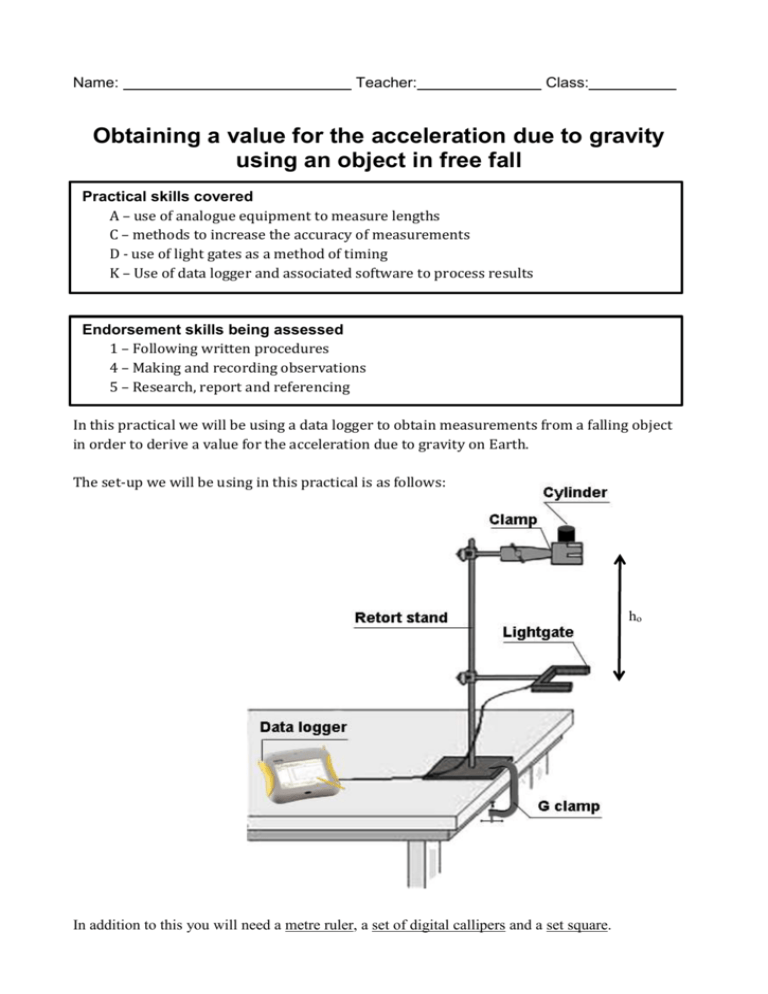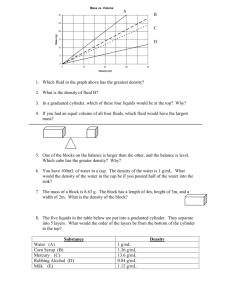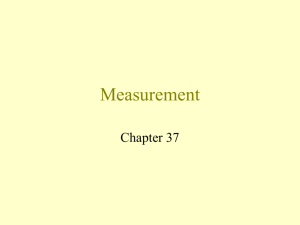in class task
advertisement

Name: Teacher: Class: Obtaining a value for the acceleration due to gravity using an object in free fall Practical skills covered A – use of analogue equipment to measure lengths C – methods to increase the accuracy of measurements D - use of light gates as a method of timing K – Use of data logger and associated software to process results Endorsement skills being assessed 1 – Following written procedures 4 – Making and recording observations 5 – Research, report and referencing In this practical we will be using a data logger to obtain measurements from a falling object in order to derive a value for the acceleration due to gravity on Earth. The set-up we will be using in this practical is as follows: ho In addition to this you will need a metre ruler, a set of digital callipers and a set square. AS Physics Practical : Measuring g by free fall Page 2 Method: 1. Set up the equipment as shown in the diagram with ho approximately 65cm. ho is measured from the base of the cylinder to be dropped (as shown in the diagram below) and the centre of the light-gate sensor which is marked with a line for you already. ho 2. Measure your value of ho ………………………… 3. Measure the length of your cylinder using the digital callipers and record your measurements in the space below ………………………… 4. How did you reduce systematic error in your measurement? …………………………………………………………………………………………… …………………………………………………………………………………………… …………………………………………………………………………………………… 5. How did you reduce random error in your measurement? …………………………………………………………………………………………… …………………………………………………………………………………………… …………………………………………………………………………………………… AS Physics Practical : Measuring g by free fall Page 3 6. You are now going to open the data logging software and input the parameters for the data logger to operate under. Follow steps 1-5 from the pictures below and make sure you press ‘OK’ when you have finished to store the settings. Step One Shortcut to MultiLabCE Steps Two & Three AS Physics Practical : Measuring g by free fall Page 4 Step Four Step Five STORE THE SETTINGS 7. Using the settings you have stored if you are taking 1000 samples per second and recording a total of 2000 samples how long will the date logger record for in seconds? ……………………………………s AS Physics Practical : Measuring g by free fall Page 5 8. With the cylinder and release mechanism in place, press the green man (step 6) to begin recording results and then release the cylinder almost immediately after recording has begun. You should be presented with a graph such as the one below which shows a peak corresponding to the cylinder passing through the light-gate. 9. Click the table icon as shown in step 7 below to access the tabulated data. Beginning at the top row scroll down until you find the first non-zero value in the voltage column and record the corresponding time; this is when the cylinder has entered the lightgate. In the picture below this occurs at time of 2370ms. Locate the final non-zero value in the voltage column and record the corresponding time; this is when the cylinder has left the light-gate. In the picture below this occurs at 2396ms. Entrance time…….…………ms Exit time…….…………ms AS Physics Practical : Measuring g by free fall Page 6 10. Find the difference between your two times to give the transit time of the cylinder through the light-gate. In the example above the transit time would be 2396ms 2370ms = transit time of 26ms Transit time (1)………….……..…………ms 11. Repeat steps 7-9 again a further two times to obtain two further transit times and then calculate an average of the three transit times. Transit time (2)…………….……….……ms Transit time (3)…….………….…………ms ……………………………………………………………………………………………… Average transit time ………….…….….……..ms 12. Assuming that the velocity of the cylinder is constant for the brief period it is passing through the light-gate, use the length of the cylinder to calculate the velocity of the cylinder as it passes through the light-gate. Velocity …………………………ms-1 13. As the cylinder is released from rest from the holder what is the initial velocity of the cylinder? Initial velocity…………………………ms-1 14. Calculate a value for the acceleration due to gravity for the cylinder falling through a height of ho, using an appropriate s, u, v, a, t equation. ……………………………………………………………………………………………… ……………………………………………………………………………………………… Acceleration……….………….……ms-2 15. To improve the validity of the experiment, we are going to repeat the procedure for differing values of h0. You are going to vary h0 for five further values between 65cm and 25cm, and record suitable time measurements from the data logger to obtain the transit velocity for each height. After resetting each value of h0 use the plumb-line to ensure the cylinder is vertically above the centre of the light-gate. You will need a column for v2 in your table. Use the space overleaf to draw your results table and record your measurements. AS Physics Practical : Measuring g by free fall Page 7 AS Physics Practical : Measuring g by free fall Page 8 16. Plot a graph of v2 against h0 on the graph paper provided. 17. The equation relating v to h0 that corresponds to your graph is: 𝑣 2 = 2𝑔ℎ0 By comparing this to the general equation of a straight line can you determine a value for the acceleration due to gravity from your graph. g =……………………………ms-2







